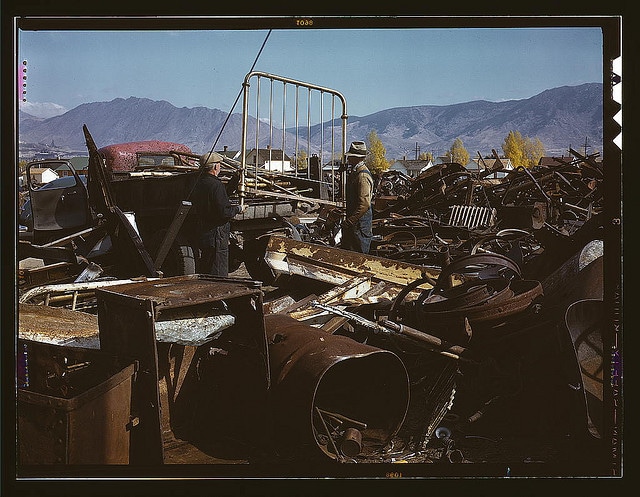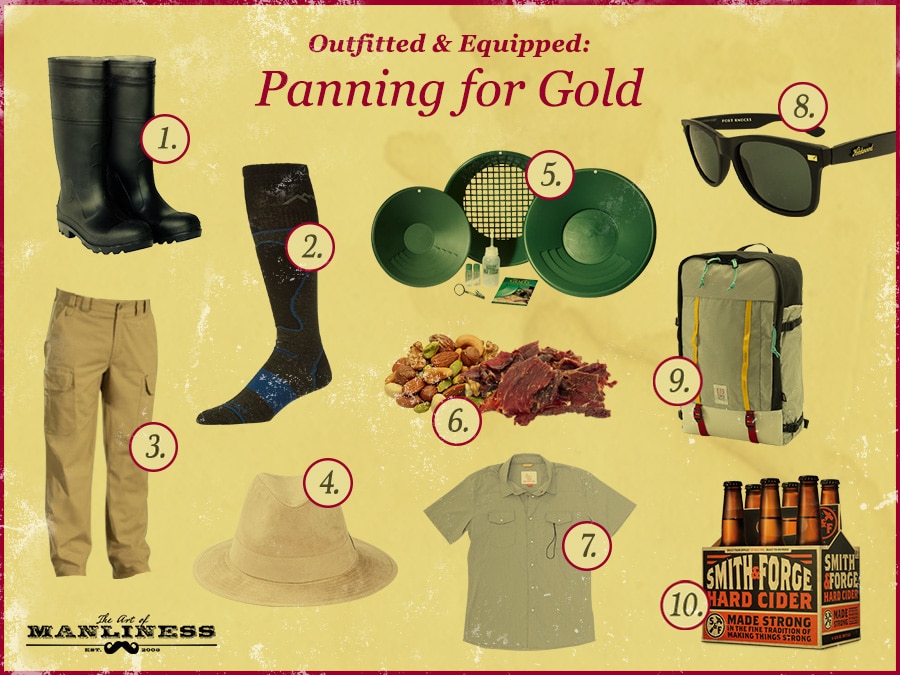
Editor’s note: This is a guest post from Josey Orr.
In 1884, when my great-great-great-grandfather Mayer Pollock was 25 years old, he came to Philadelphia from Russia. He traveled alone, leaving his young wife and son behind so that he could go forth and create a life for them in America. In an effort to save the money needed to bring the rest of the family over, he began collecting metal pots and pans and peddling them for money. He would walk all around with a backpack and collect as much as he could every day. It was certainly a struggle, but after a year he had saved enough to bring his wife, son, and father to America.
During the travels with his pack, there were various farmers on his route that he would sometimes stop and stay overnight with. One farmer in particular noticed how exhausted Mayer was from walking around with a pack filled with metal all day and suggested that he buy a horse and carriage. When Mayer explained to the farmer that he didn’t have the funds to buy a horse and carriage, the farmer lent him $100 so that he could. The money was just enough to buy a carriage and an old, blind horse. With his new “machinery” he was able to start purchasing heavier steel scrap from farmers and blacksmiths.
After about 10 years, Mayer had moved from Philadelphia and settled in Pottstown, Pennsylvania. At this time, he had grown his small enterprise to the point where he owned about 12 horses, a small lot to store the metal, and a small home with a stable for his family and the horses. When he could afford it, he paid to have his wife’s family brought over from Europe. They sometimes slept three to a bed in the small house, but there was also enough men available now for each to take a horse and carriage out to collect metal. From here, the business continued to grow, some years quickly and some years not at all, to what it is today. Mayer Pollock Steel Corporation is one of America’s oldest scrapyards and is currently owned by my father. There are now three locations and a demolition crew under the MP umbrella. The company has survived many ups and downs and has been an official business for over 115 years. I worked there my entire life before starting an American-made men’s clothing brand called Dyer and Jenkins. During my time in the scrapyard I was able to learn a lot about metal and how an average person can earn a little extra cash by collecting it and bringing it to their local scrapyard. Today I’ll share my tips with you.
Getting Started
What You’ll Need
You don’t need a lot to get started. Here is what you’ll need:
- A magnet. The most handy tool for all scrappers. A pocket-sized one does the trick just fine. You’ll use this to distinguish ferrous from nonferrous metals (more on that below). If the magnet is drawn to the metal, it’s most likely ferrous.
- Something to collect metal in – a truck, a barrel, a cardboard box.
- Basic knowledge of different types of metals.
Where can you find metal?
You can find scrap metal all over the place. Sometimes, people just throw it away because they don’t know the value of it. You can go from door to door and pass out flyers letting people know that you collect and scrap metal and would be happy to take it off of their hands. If circumstances allow it, you can go into buildings and demolition sites to collect metal. However, you must always have permission to go onto property that isn’t yours in order to collect metal. If you do not get permission, you could be prosecuted for theft.
The best way to be successful is to find a recurring source of scrap. You can also check out the free section of Craigslist.
Collecting/Sorting Metals
The following is very important. Knowing how to collect and separate your metals will ensure that you get the most money possible for your load. Here are a few basic tips:
- Put each type of metal in its own container. You don’t want your metals all mixed together when you show up at a scrapyard. The main reason is that you’ll most likely get paid only for the value of the least valuable metal in your box or you’ll be told to separate it and come back. For example, if you have brass and aluminum mixed together in one bucket, you may only get paid aluminum prices, which would suck because brass pays a lot more per pound.
- Clean your scrap. No, I don’t mean wash it off with soap and water. Clean scrap means that there are no extra attachments on the metal you are cashing in. The difference between #1 Copper and #2 Copper is very simple. #1 Copper is free of any paint or brass attachments which means that 99% of the weight is Copper. #2 Copper would mean that 96% or more of the weight is copper, but it may have paint or brass or some other metal attached to it, causing it to be downgraded.
- Keep your scrap safe. Scrap metal is often stolen from business, construction sites, and homes. Keep your collection in a safe place.
Knowing Your Metals
What’s the difference between ferrous and nonferrous metals?
The simplest answer is that ferrous metals and alloys contain iron (Fe) and nonferrous metals do not. Which is exactly why a magnet is your most useful tool in separating and collecting metals. If your magnet sticks to a piece of metal, chances are it’s ferrous. If it doesn’t stick, chances are it’s nonferrous.
The reason this is important is because there is typically a significant price difference between the two; nonferrous metals often pay more per pound than ferrous metals do. So if your magnet doesn’t stick, you’re looking at a little more cash in your pocket.
Common Nonferrous Metals
Aluminum – Window frames, building structures, roofs, airplanes, trains, boats, cars and trucks. It is also used in smaller vehicles like bicycles, motorbikes, and other mobility devices such as wheelchairs. Keep in mind that if there is iron (use your magnet) attached to any of these things it will need to be removed in order for you to get full aluminum prices for scrap. Of course, your old soda and beer cans also can be recycled, but it will take a lot of volume to make an amount of money that’s worth it.
Brass – Most commonly scrapped are valves and pipefittings. Some other items made from brass include: bullet casings, faucets, doorknobs, and light fixtures.
Copper – Copper pipe, wires, circuits, switches, and electromagnets. A few others are plumbing fittings and also pieces found in refrigeration units, air conditioners, and water supply systems.
Lead – Lead is used in many different applications from piping to wheel weights. It’s usually soft and somewhat pliable, but it’s deceptively heavy.
Stainless Steel – Although containing 70% iron, stainless steel is still considered a nonferrous metal and fetches a higher price. The reason it is more valuable is because it is made using a minimum of 8% nickel. Stainless steel can often be found in appliances and kitchenware as well as some automotive and aerospace technology. It will probably look like regular steel, but will not draw a magnet.
Ferrous Metals
While there are a large variety of ferrous metals (the most common being varieties of steel and iron), what’s most important to know are the following two categories of ferrous metal:
New Scrap – Excess from the production lines of manufacturing warehouses. The common person will not likely have access to this type of metal.
Obsolete Scrap – Old stuff: appliances, lawnmowers, cars – anything that’s old and made of steel. Both new and obsolete scrap will draw the pull of a magnet. I’ve listed some common items below:
Automobiles – Yes, you can scrap an entire vehicle if you want to. A lot of people I know will just sit some old hunk of junk in their yard forever because it doesn’t run and they never find the time to fix it. The good news is that you can scrap it if you can’t fix it or sell it. I’d recommend stripping off anything that contains aluminum or other nonferrous metals because you can get more money for them. Also, before taking the car in, you should call ahead to the local scrapyard to see what they need from you in order to buy it. Most yards will need you to present the title and empty it of all liquids. Emptying the liquids from the car sucks, trust me; I spent an entire summer doing it once, but it’s worth it if you’re getting paid.
Washers, Dryers, Heaters, Other Appliances – Most scrapyards take them all. So, if you’ve recently replaced any of these household appliances lately you can get some decent scrap money for them instead of letting them sit in your garage.
Structural Steel – Prepared I-beams, channels, angles and/or plates, steel girders, and structural steel from demolition scrap. This is the stuff that typically holds up bridges and buildings.
Cashing In
Where can you take your metal to sell?
Now that you’ve collected and separated your metals, you’re ready to cash in. You’ll want to take your goods to the local scrapyard.
A scrapyard differs from a junkyard, but only slightly. They both may look the same to an outsider, but scrapyards focus only on buying and selling metal, whereas there are a variety of other things that can be found in a junkyard. Junkyards have also been historically used as auto wrecks and parts yards.
Your best bet is to call ahead to any of your local scrapyards and figure out which one is offering the best prices for the metal. In most cases you will find that they are all comparable to one another. Some yards pay you in cash and some will write you a check.
You can also use the iScrap App to find scrapyards in your local area.
How much can one stand to make scrapping?
The amount of money any one person can make scrapping ranges from a few extra bucks a month for beer, to a few thousand if you have a connection to a business that generates scrap regularly. It all depends on what and how often you scrap. Also keep in mind that market prices are always changing based on supply and demand.
Having said that, here are some rough numbers to work from:
- Light iron and other ferrous metals: $.06-$.10 per lb, but they are more commonly found so it’s easier to get more weight.
- Copper: $2.65 per lb.
- Insulated copper wire: $.90 per lb.
- Brass: $1.60 per lb.
- Stainless steel: $.42 cents per lb.
- Aluminum: $.50 cents per lb.
It’s not uncommon for a scrapper to make up to $100-$200 a day from their hauls. Not bad if you’re looking to generate a little extra cash before the holidays!
Are you a scrapper? What tricks of the trade can you share?
______________________________
Josey Orr is a former employee of Mayer Pollock Steel Corporation.







